Welcome to our comprehensive guide on Bacopa caroliniana, the versatile aquatic plant that can elevate the beauty of your freshwater aquarium.
Whether you’re a seasoned aquatic gardening enthusiast or just starting in aquarium plant care, bacopa caroliniana is a submerged plant that deserves your attention.
Also known as naja grass or water hyssop, this plant offers aesthetic appeal and various benefits for your aquarium ecosystem.
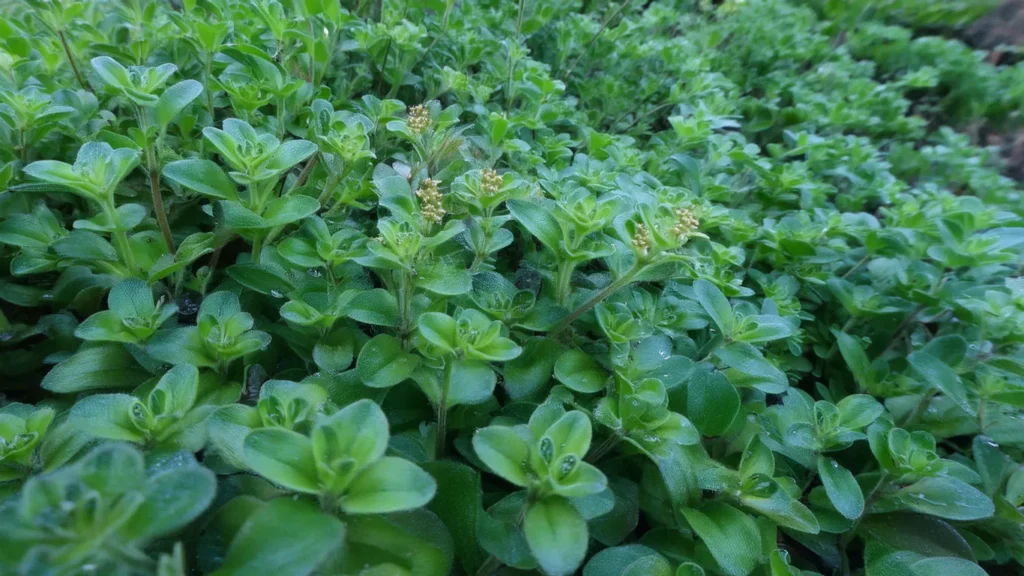
Bacopa caroliniana is a versatile plant that can be used as a foreground plant or placed in the background, providing depth and structure to your aquarium landscape.
With its lush green foliage and the potential to produce beautiful blue or purple flowers when grown emersed, bacopa caroliniana can create a visually stunning aquarium environment.
Whether you’re looking to create a natural habitat or craft impressive aquarium landscaping, it’s a fantastic choice.
In this article, we will delve into the optimal growing conditions for Bacopa caroliniana, its benefits, water parameters, lighting strategies, temperature requirements, propagation techniques, nutrient supplementation, and common challenges associated with this versatile aquatic plant.
By the end, you’ll have a comprehensive understanding of cultivating and caring for bacopa caroliniana in your freshwater aquarium.
Key Takeaway
- Bacopa caroliniana is a versatile aquatic plant that can enhance the beauty of your freshwater aquarium.
- It can be used as a foreground or background plant, adding depth and structure to your aquarium landscape.
- When grown emersed, Bacopa caroliniana can produce blue or purple flowers, adding aesthetic value to your aquarium.
- We will cover optimal growing conditions, benefits, water parameters, lighting strategies, temperature requirements, propagation techniques, nutrient supplementation, and common challenges associated with bacopa caroliniana.
- By the end of this article, you’ll have the knowledge to cultivate and care for bacopa caroliniana successfully.
Quick Stats
| Attribute | Details |
| Family Name | Plantaginaceae |
| Origin | Southeastern United States |
| Height | 10-30 cm (4-12 inches), can reach up to 50 cm (20 inches) in optimal conditions |
| pH Range | 6.0 – 7.5 |
| CO2 Requirement | Low to Moderate |
| Growth Rate | Moderate |
| Care Level | Easy |
| Color Form | Green, sometimes with a bronze hue under high light |
| Water Conditions | 18-28°C (64-82°F), soft to moderately hard water |
| Max Size | Stems can grow up to 50 cm (20 inches) tall |
| Lighting | Moderate to High |
| Supplements | CO2 fertilization and a balanced liquid fertilizer |
| Placement | Mid-ground to Background |
| Propagation | Stem cuttings |
What Is Bacopa Caroliniana?
Bacopa Caroliniana is an aquatic plant native to the marshy areas of the southern United States. This slow-growing stem plant can reach heights of over 60 cm, making it ideal for aquarium backgrounds.
The leaves of Bacopa Caroliniana have a unique texture that sets them apart from other plants in the aquarium.
When grown emersed, the plant produces attractive blue or purple flowers, adding a touch of beauty to any aquatic environment.
Other scientific names, including Bacopa amplexicaulis, Obolaria caroliniana, Herpestes amplexicaulis, and Herpestes caroliniana, also know this versatile plant.
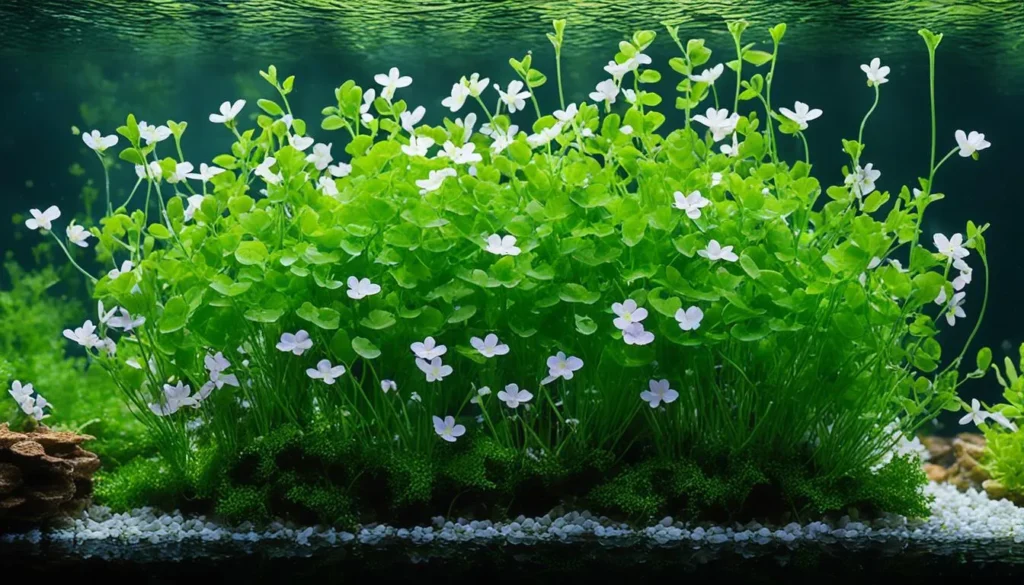
Natural Habitat And Origin
Bacopa caroliniana is native to North America, particularly the southeastern United States. It is commonly found growing in aquatic habitats such as ponds, lakes, marshes, and slow-moving streams.
In its natural habitat, Bacopa caroliniana thrives in areas with ample sunlight and nutrient-rich waters. It often grows submerged or partially submerged, with its stems and leaves extending above the water’s surface.
This versatile plant can also adapt to emersed growth, where it can be found along the edges of water bodies, wetlands, and damp soil.
Physical Characteristics Of Bacopa Caroliniana
- Stem Structure: Bacopa caroliniana features slender, branching stems that can grow upright or trail along the substrate. The stems are typically green to reddish-brown in color and can reach lengths of up to 30 centimeters (12 inches) or more.
- Leaves: The leaves of Bacopa caroliniana are small, oval-shaped, and arranged oppositely along the stems. They are typically light green in color, although they may develop red or purple hues under certain lighting conditions. The leaves have smooth margins and a glossy texture.
- Growth Habit: Bacopa caroliniana exhibits a relatively slow to moderate growth rate under optimal conditions. It tends to grow vertically, with new stems branching off from the main stem as the plant matures. This growth habit makes it suitable for background or midground planting in aquariums.
- Root System: The root system of Bacopa caroliniana consists of fine, fibrous roots that anchor the plant in the substrate. These roots absorb water and nutrients from the surrounding environment to support the plant’s growth and development.
Lighting Strategies To Enhance Bacopa Caroliniana’s Vibrance
- Proper lighting is essential for enhancing the vibrant coloration of Bacopa Caroliniana in your freshwater aquarium.
- This versatile aquatic plant thrives under high-intensity full-spectrum lighting, with a recommended minimum of 0.5 watts per liter.
- The right lighting not only promotes healthy growth but also enhances the plant’s natural hues, creating a visually appealing and vibrant display in your aquarium.
- When setting up the lighting for your Bacopa Caroliniana, it is important to ensure that light reaches the plant’s lower leaves, as they are susceptible to deterioration if not exposed adequately.
- To achieve this, consider pruning and replanting the upper part of the plant, which allows brighter light to reach the lower leaves and stimulates new growth.
Maintaining Ideal Temperatures For Bacopa Caroliniana Growth
- Bacopa Caroliniana, just like any other aquatic plant, requires specific temperature conditions to thrive and grow vigorously. Maintaining optimal temperatures is crucial for the overall well-being and health of the plant. The recommended temperature range for optimal Bacopa Caroliniana growth is between 68-82°F.
- While this plant is known for its adaptability and ability to tolerate cooler temperatures, it is important to avoid exposing it to water colder than 59°F. Growth slows down significantly below this threshold, affecting the plant’s development and appearance.
- To ensure that the temperature remains within the ideal range, it is essential to monitor the water temperature using a reliable thermometer regularly. This will allow you to make any necessary adjustments to the tank’s heating system or water source to maintain a consistent temperature for Bacopa Caroliniana.
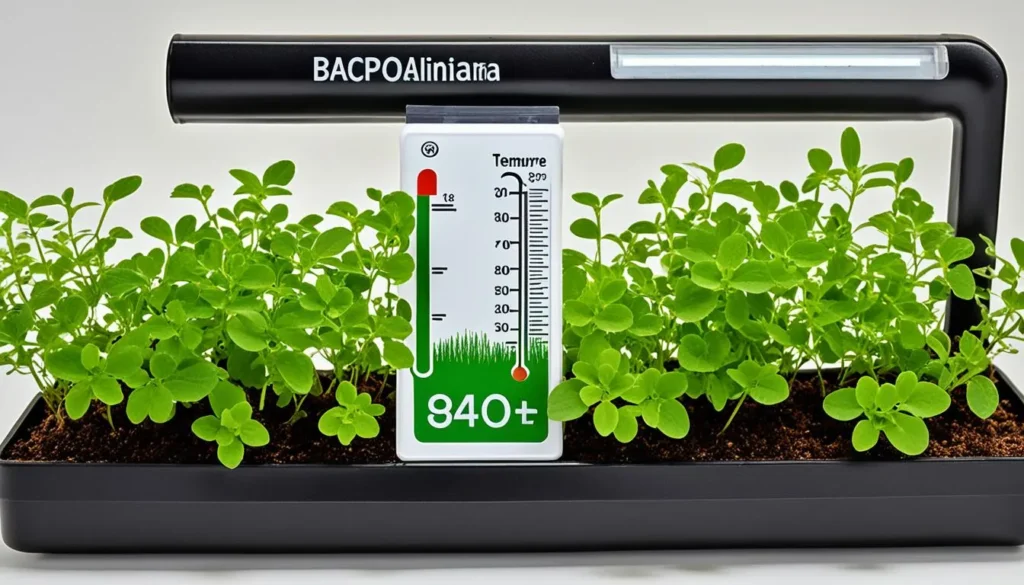
Optimal Growing Conditions For Lush Bacopa Caroliniana
To ensure the lush growth of Bacopa Caroliniana, it is important to provide the plant with optimal growing conditions.
This includes maintaining proper water parameters such as a pH range of 6.0-8.0 and water hardness between 2-15 GH.
The plant also thrives under high-intensity full-spectrum lighting, with a recommended minimum of 0.5 watts per liter. Temperature-wise, Bacopa Caroliniana prefers a range of 68-82°F for optimal growth.
Regular water changes and nutrient supplementation are essential to prevent deficiencies and promote healthy growth.
| Water Parameters | Lighting | Temperature | Other Requirements |
| pH: 6.0-8.0Water Hardness: 2-15 GH | High-intensity full-spectrum lightingMinimum 0.5 watts per liter | 68-82°F | Regular water changesNutrient supplementation |

Benefits Of Bacopa Caroliniana
- Cultivating Bacopa Caroliniana in your freshwater aquarium offers several benefits. This versatile plant adds aesthetic appeal with its lush green foliage and the potential for colorful flowers.
- It can create a natural and vibrant landscape in your aquarium, providing hiding spots and shelter for fish and other aquatic inhabitants. Bacopa Caroliniana also helps to maintain water quality by absorbing excess nutrients and providing a source of oxygen for fish.
- This plant is also low-maintenance and can tolerate varying water conditions, making it suitable for novice and experienced aquarium enthusiasts.
Substrate Requirements
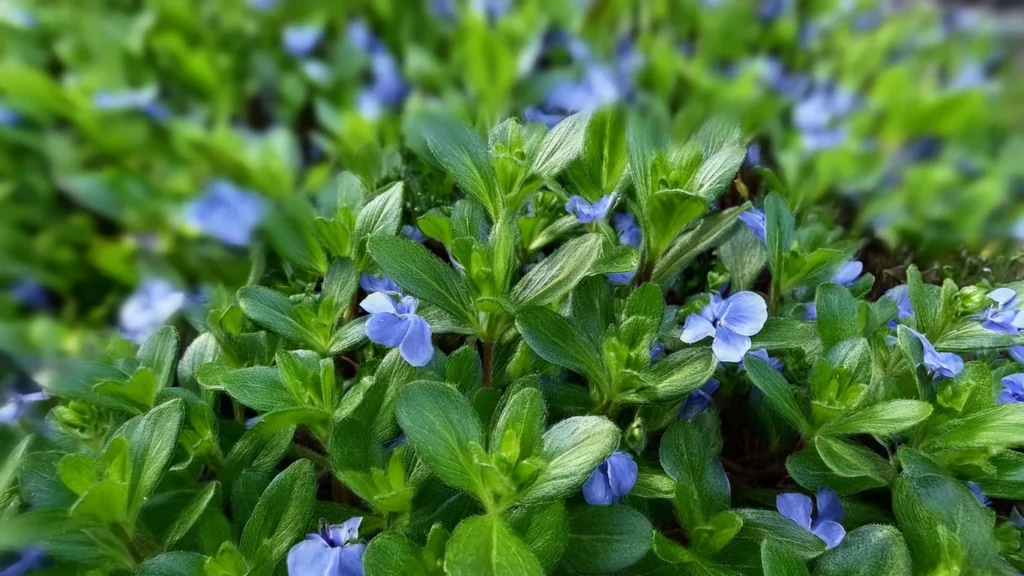
Critical Water Parameters For Bacopa Caroliniana Health
- Temperature: Maintain water temperatures between 22°C to 28°C (72°F to 82°F). Bacopa caroliniana can tolerate a wide range of temperatures but grows best within this range.
- pH Level: Bacopa caroliniana prefers slightly acidic to neutral water conditions with a pH range of 6.0 to 7.5. Ensure that the pH remains stable within this range for optimal growth.
- Water Hardness: It can adapt to varying water hardness levels, but soft to moderately hard water is generally preferred. Aim for a water hardness of 2 to 15 dGH (German degrees of hardness).
RELATED: The Aquatic Wonder Bacopa Australis To Transform Your Aquascape
Placement Options
- Background Planting: Bacopa caroliniana is often used as a background plant due to its tall and upright growth habit. Plant it along the back or sides of the aquarium to create a lush green backdrop. This placement helps add depth to the aquascape and provides a natural-looking environment for midground and foreground plants.
- Midground Planting: In larger aquariums, Bacopa caroliniana can also be placed in the midground to break up the space between foreground and background plants. Arrange it in groups or clusters to create focal points and add visual interest to the middle portion of the tank.
- Foreground Accent: While Bacopa caroliniana is typically used in the background or midground, shorter varieties or trimmed stems can be placed in the foreground as accent plants. Use them to fill in gaps between foreground plants or create transition zones between different areas of the tank.
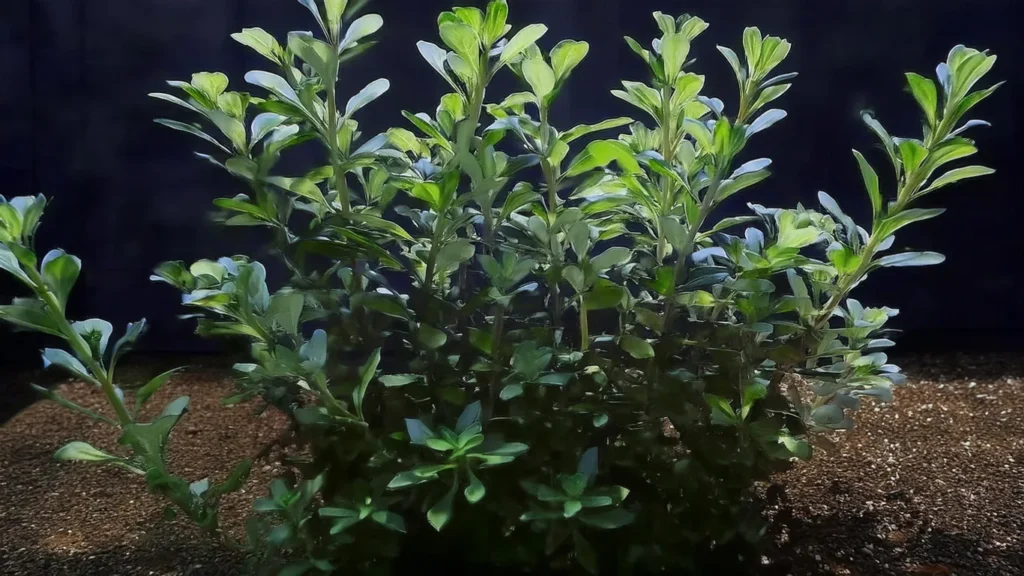
Propagation Techniques For Expanding Your Bacopa Caroliniana Collection
- One effective method is stem planting. Start by selecting lengths of 3-6 inches from a healthy Bacopa Caroliniana plant. Remove the bottom 2 inches of leaves and carefully plant the stems into the substrate, ensuring they are securely positioned. Over time, new roots will develop, resulting in a thriving new plant.
- If you want to encourage bushier growth and stimulate new shoots, pruning and replanting the tops of the Bacopa Caroliniana plant can be beneficial. Simply trim the upper part of the stem and replant it in the substrate. This process promotes branching and encourages new growth, creating a fuller and more visually appealing appearance.
- Allowing fallen leaves to float in the tank can also lead to new growth. These leaves may develop roots or give rise to new shoots, creating additional plants that can be transplanted into the substrate for continued expansion of your Bacopa Caroliniana collection.
Nutrient Supplementation For Robust Bacopa Caroliniana Growth
Nutrient supplementation is crucial for promoting the robust and healthy growth of Bacopa Caroliniana.
By providing targeted fertilization, the plant can receive the necessary macronutrients and micronutrients to prevent nutrient deficiencies, ensuring optimal health and vibrant coloration.
Preventing Deficiencies With Targeted Fertilization
- One important aspect of nutrient supplementation is targeted fertilization, which involves providing the specific nutrients that Bacopa Caroliniana requires. This prevents nutrient deficiencies and promotes healthy growth.
- For instance, iron supplements can be used to correct chlorosis, especially in new growth. At the same time, Epsom salt (magnesium sulfate) can address interveinal chlorosis and leaf margin curling caused by magnesium deficiency.
- You can ensure the plant’s optimal health by monitoring nutrient levels and providing appropriate fertilization.
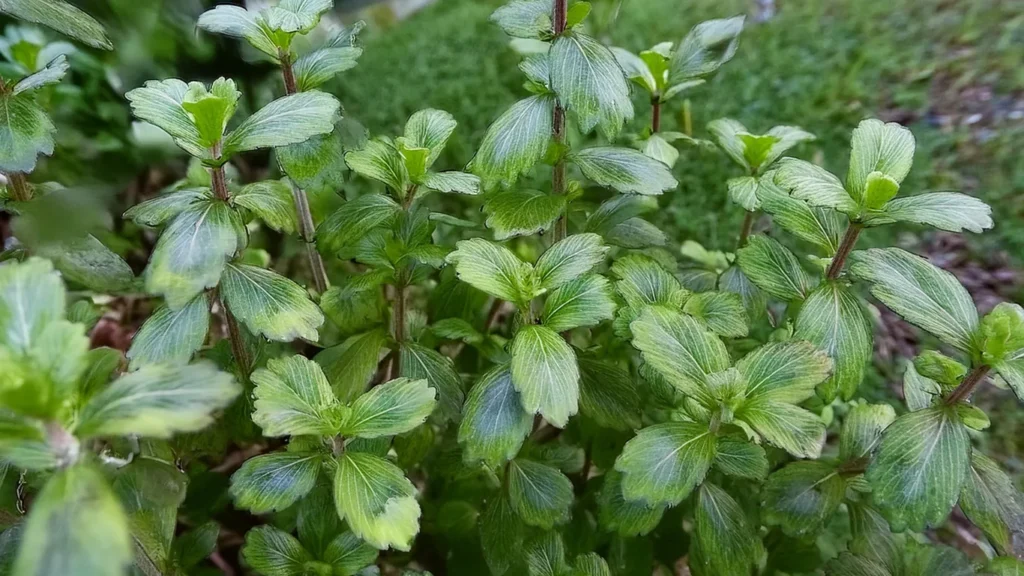
Enhancing Pigmentation Through Micronutrients
- In addition to macronutrients, micronutrients play a crucial role in enhancing the pigmentation of Bacopa Caroliniana, making it visually captivating.
- These micronutrients can enrich the colors of the plant, adding a unique aesthetic touch to your aquarium. By incorporating micronutrients into your nutrient supplementation routine, you can further enhance the beauty of Bacopa Caroliniana.
| Nutrient | Role | Deficiency Symptoms | Supplementation Methods |
| Iron | Essential for chlorophyll production | Yellowing of leaves (chlorosis) | Iron supplements or iron-rich fertilizers |
| Magnesium | Component of chlorophyll | Interveinal chlorosis, leaf margin curling | Epsom salt (magnesium sulfate) |
| Micronutrients | Enhancement of pigmentation | Pale or dull colors | Commercial micronutrient fertilizers |
Addressing Common Aquatic Plant Challenges
- While Bacopa Caroliniana is generally an easy-to-maintain aquatic plant, it can still face common challenges. Two of the most common issues that aquarists may encounter with Bacopa Caroliniana are floating stems and pest infestations.
- To prevent these challenges, it is important to take certain precautions. When introducing new Bacopa Caroliniana plants to your aquarium, it is recommended to quarantine them first.
- This helps ensure that potential pests or diseases are isolated and not spread to the main aquarium. It is also important to properly disinfect aquarium plants before adding them to your tank to minimize the risk of introducing unwanted pests or pathogens.
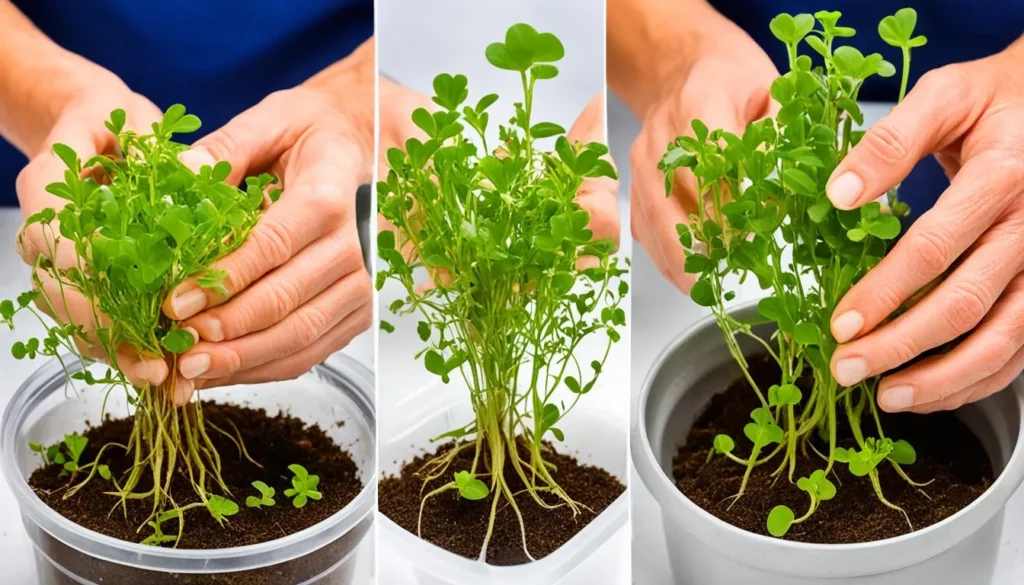
| Common Challenges for Bacopa Caroliniana | Troubleshooting Tips |
| Floating stems | – Trim excess stem length to maintain proper buoyancy- Ensure adequate nutrient levels and light penetration to promote healthy root growth |
| Pest infestations | – Quarantine new plants before introducing them to the main aquarium- Disinfect plants before adding them to the tank- Monitor and address any signs of pests promptly |
| Overcrowding | – Prune and replant stems to maintain appropriate spacing- Avoid overcrowding by not adding too many stems in a confined area |
Conclusion
Cultivating Bacopa Caroliniana in your freshwater aquarium can bring numerous benefits and enhance its overall beauty.
This versatile and adaptable aquatic plant can thrive in various water parameters, lighting conditions, and temperatures, making it suitable for aquarists of all levels of experience.
It offers aesthetic appeal with its lush green foliage and the potential for colorful flowers when grown emersed.
It also contributes to water quality improvement by absorbing excess nutrients and providing a source of oxygen for fish.
Additionally, this plant has low maintenance requirements, making it a convenient choice for aquarium enthusiasts.
By providing optimal growing conditions, addressing water parameter preferences, implementing suitable lighting strategies, maintaining proper temperatures, employing propagation techniques, and supplementing nutrients, you can cultivate a healthy and vibrant collection of this plant in your aquarium.
With its beauty, versatility, and ease of care, It is an excellent choice for aquascaping and creating a thriving aquatic environment.
Frequently Asked Question
How Does Bacopa Caroliniana Affect The Nitrogen Cycle In Planted Aquariums?
Bacopa caroliniana plays a significant role in the nitrogen cycle within planted aquariums. Its rapid growth rate and substantial biomass make it efficient at absorbing nitrogenous compounds, such as ammonia, nitrites, and nitrates, from the water column.
This absorption process helps to purify the water, reducing the likelihood of harmful nitrogen spikes that can affect fish and other aquatic life.
Additionally, Bacopa caroliniana’s ability to uptake nitrates makes it an excellent candidate for natural algae control, as it competes with algae for nutrients.
Can Bacopa Caroliniana Thrive In Brackish Water Conditions, And How Does Salinity Affect Its Growth?
It is predominantly a freshwater plant but can tolerate low levels of salinity, making it suitable for some brackish water conditions. Salinity levels up to 1.003 specific gravity (roughly 5 parts per thousand) are generally tolerable.
However, higher salinity can lead to reduced growth rates, diminished leaf size, and potentially a lighter coloration of the foliage.
It’s essential to acclimate the plant gradually to brackish conditions to minimize stress and allow adaptation to the new environment.
What Are The Specific Light Requirements For Bacopa Caroliniana To Achieve Optimal Growth And Coloration?
It requires moderate to high lighting conditions to thrive and exhibit vibrant coloration. Light intensity between 50 to 70 micromoles of PAR (Photosynthetically Active Radiation) is ideal for promoting robust growth and the development of the characteristic pink to bronze hues on the leaves under high light conditions.
In lower light, the plant tends to grow taller and produce greener foliage. Consistent light exposure for 10-12 hours a day is recommended to simulate natural conditions and encourage healthy growth.
How Does Bacopa Caroliniana Propagate Naturally In The Wild, And How Can These Methods Be Replicated In An Aquarium Setting?
In its natural habitat, this plant propagates primarily through stem cuttings and occasionally through seed dispersal after flowering. In an aquarium or cultivated setting, the most effective way to propagate it is by trimming the top portion of the stem and replanting the cutting in the substrate.
This method encourages the parent plant to branch out, leading to a fuller appearance, while the cutting establishes a new root system and grows into a new plant. Regular pruning not only facilitates propagation but also promotes denser growth and maintains the desired plant height.
What Are The Common Pests And Diseases That Affect Bacopa Caroliniana, And How Can They Be Managed?
It is relatively hardy but can be susceptible to pests such as aphids and spider mites, especially when grown emersed or in outdoor ponds. Algae growth on the leaves can also be an issue in aquariums with excessive nutrients or light.
Managing pests involves physically removing them or treating the plants with insecticidal soaps or specific aquatic-safe pesticides. Algae issues can be mitigated by controlling nutrient levels, adjusting lighting, and introducing algae-eating fish or invertebrates.
Regular monitoring and maintenance are crucial to prevent infestations and ensure the health of it.
- Unveiling The Wonders Of Riccia Fluitans In Aquascapes - August 7, 2024
- Vallisneria Gigantea Var. Guide To Care And Cultivation At Home - July 31, 2024
- Vesicularia Dubyana Care & Growth Guide Tips For Beginner Gardeners - July 30, 2024
